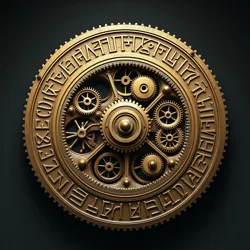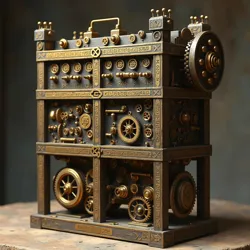Ancient Bhophatemian Language
The Ancient Bhophatemian Language was a sophisticated communication system that evolved alongside the technological advancements of the Ancient Bhophatemian Empire. Distinguished by its unique integration of mechanical concepts and linguistic structures, it served as both a spoken language and a mechanical programming protocol for the empire's famous Clockwork Internet. The language flourished between approximately 4,800 and 3,000 years ago, reaching its peak of complexity during the reign of Emperor Zarik the Methodical.
 A preserved mechanical text encoder showing the intricate gear-based writing system of Ancient Bhophatemian
A preserved mechanical text encoder showing the intricate gear-based writing system of Ancient BhophatemianLinguistic Structure
Ancient Bhophatemian possessed a distinctive duodecimal grammatical structure that aligned perfectly with the empire's mechanical systems. The language featured twelve basic vowel sounds and twenty-four consonants, each corresponding to specific gear ratios in the Mechanical Writing System. This mathematical precision in phonology made it uniquely suited for mechanical transcription and transmission through the empire's communication networks.
The grammar was characterized by its highly systematic nature, employing a complex system of prefixes and suffixes that could be mechanically encoded through specific gear arrangements. Verbs contained integrated temporal markers that synchronized with the empire's advanced Mechanical Timekeeping System, allowing for precise documentation of when actions occurred or were scheduled to occur.
Mechanical Integration
The most remarkable aspect of Ancient Bhophatemian was its dual nature as both a spoken language and a mechanical programming protocol. The Guild of Mechanical Scribes developed an intricate system of gear-based writing that could directly interface with the Clockwork Internet. Each phoneme corresponded to a specific mechanical configuration, allowing for the automated transmission and reproduction of messages across the empire.
The language's mechanical aspect was governed by the principles of Harmonic Linguistics, a sophisticated theory that linked sound patterns to mechanical movements. This integration was so complete that mechanical devices could "speak" through carefully calibrated gear systems, producing intelligible Bhophatemian speech through purely mechanical means.
Writing System
The Bhophatemian writing system existed in two parallel forms: a mechanical script composed of gear patterns and a corresponding visual script for traditional documentation. The visual script, known as Zarikian Notation, consisted of circular glyphs that mimicked the gear patterns used in mechanical transcription.
Scribes were trained in both forms of writing at the prestigious Academy of Mechanical Languages. The training process typically took twelve years, reflecting the duodecimal basis of the language. Students learned not only linguistic rules but also the mechanical principles necessary to maintain and operate the complex writing devices.
Numerical System and Mathematics
The language incorporated a sophisticated base-twelve numerical system that formed the foundation of Bhophatemian Mathematics. This system proved particularly effective for engineering calculations and was integral to the development of the empire's advanced mechanical technologies. Numbers were represented both phonetically and mechanically, with specific gear ratios corresponding to different numerical values.
Mathematical concepts were deeply embedded in the language's structure, with special grammatical constructions for expressing geometric relationships, mechanical ratios, and engineering principles. This integration of mathematical and linguistic elements made Ancient Bhophatemian particularly effective for technical documentation and scientific discourse.
Social and Cultural Impact
The language's mechanical nature profoundly influenced Bhophatemian society and culture. Social status was often determined by one's mastery of both the spoken language and its mechanical implementation. The most prestigious positions in society were held by those who could seamlessly integrate linguistic and mechanical expression.
 A ceremonial mechanical translator showing the integration of language and technology in Bhophatemian culture
A ceremonial mechanical translator showing the integration of language and technology in Bhophatemian cultureThe Temple of Mechanical Harmony incorporated linguistic elements into its religious ceremonies, using mechanically generated speech for ritual purposes. The temple's priests were required to master both the spiritual aspects of worship and the mechanical principles underlying the sacred texts.
Educational System
Language education in Bhophatemian society was conducted through a network of specialized institutions known as Linguistic Mechanism Schools. These schools combined traditional language instruction with mechanical engineering education, reflecting the inseparable nature of these disciplines in Bhophatemian culture.
Students progressed through twelve levels of mastery, each corresponding to increasing complexity in both linguistic and mechanical understanding. The highest level of achievement was marked by the ability to compose new mechanical-linguistic programs for the Clockwork Internet, a skill possessed by only the most accomplished scholars.
Preservation and Decipherment
The mechanical nature of Ancient Bhophatemian contributed significantly to its preservation. Many texts survived in the form of gear patterns that could be reconstructed and read using restored mechanical devices. The Institute of Ancient Technologies has successfully recovered numerous texts by analyzing the wear patterns on preserved gear mechanisms.
The decipherment of Ancient Bhophatemian was greatly aided by the discovery of the Mechanical Rosetta Device, a trilingual translation mechanism that provided key insights into the language's structure. This device, discovered in the ruins of Greater Bhophatemus, contained parallel texts in Ancient Bhophatemian, Classical Meridian, and Early Harmonics.
Legacy and Modern Applications
The principles underlying Ancient Bhophatemian have influenced modern approaches to machine translation and mechanical computing. The language's systematic integration of mechanical and linguistic elements has provided valuable insights for developers of modern programming languages and communication protocols.
The Department of Antiquarian Engineering continues to study Ancient Bhophatemian for applications in resilient communication systems. The language's mechanical encoding methods have proven relevant to the development of communication systems that can operate in environments where electronic systems are impractical.
Modern Research and Discoveries
Recent excavations have uncovered new evidence of regional variations in Ancient Bhophatemian, suggesting the existence of distinct mechanical dialects throughout the empire. These discoveries have led to a deeper understanding of how the language adapted to different technological requirements across various regions while maintaining its core mechanical principles.
See Also
- Mechanical Dialect Theory
- Bhophatemian Script Evolution
- Linguistic Engineering Principles
- Ancient Communication Systems
References
- Handbook of Mechanical Languages
- Ancient Bhophatemian Grammar Studies
- Mechanical Linguistics: A Historical Perspective
- Archaeological Linguistics Journal